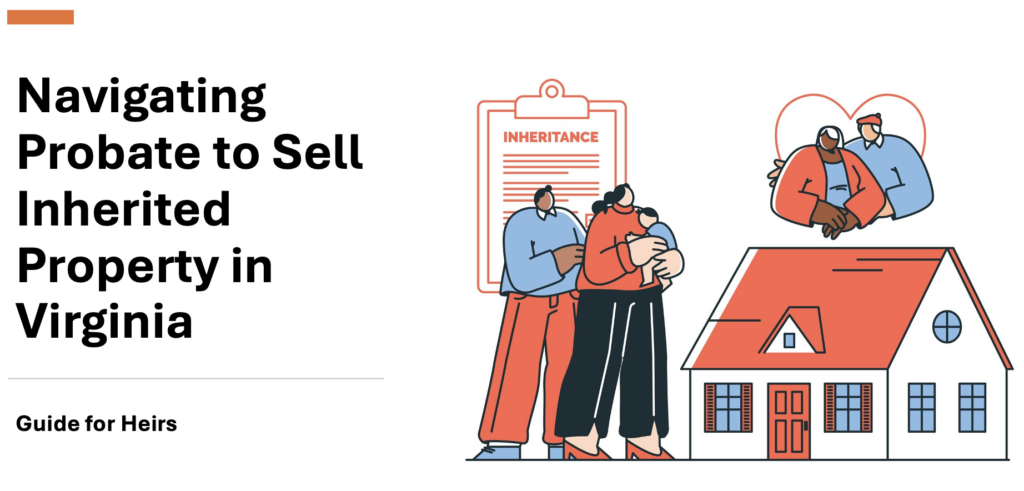Losing a loved one is never easy, and dealing with legal and financial matters in the midst of grief can feel overwhelming. If you’ve inherited real estate in in Virginia, especially without a will in place, you may be facing an uncertain and complicated process. Understanding your rights and the necessary steps will help you avoid unnecessary legal conflicts and financial setbacks.
🚀 Want a step-by-step guide on navigating probate and selling an inherited home? Download Our Free Probate Guide Now!
If you’re looking for a step-by-step guide to handling probate smoothly, we’ve put together a Free Probate Guide to help you through this process.
1. Understanding Your Ownership Rights
The first step when inheriting real estate is to determine who has legal ownership of the property. Without a will, the division of assets follows intestate succession laws, which vary by state.
- If the deceased was married, the surviving spouse often inherits the property.
- If they were unmarried, ownership may be divided among children, parents, or siblings, depending on the state’s intestacy laws.
- If there are multiple heirs, such as siblings or extended family, shared ownership can create legal and financial challenges that must be addressed.
Understanding your ownership status is crucial before making any decisions. If you’re unsure where to start, our Free Probate Guide explains intestate succession laws in detail. Get Your Copy Here!
Get Your Free Probate Guide!
Download our comprehensive guide, “Navigating Probate to Sell Inherited Property” and gain:
✅ Step-by-step instructions
✅ Links to essential forms and resources
✅ Pro tips for a smooth property sale
✅ Clear timelines and next steps

2. Determining the Value of the Property
Before making any decisions about keeping or selling the inherited real estate, you need to know how much it’s worth. The best way to do this is through a professional property appraisal.
How to Get an Accurate Property Valuation
- Hire a Licensed Appraiser – A professional appraisal will provide an official market value based on the property’s condition, location, and recent sales.
- Consult a Real Estate Agent – Local real estate experts can offer comparative market analysis (CMA) based on similar properties.
- Use Online Valuation Tools – While not as accurate as an appraisal, online valuation tools can provide a general estimate.
Understanding the property’s market value will help you make informed decisions, whether you plan to keep, rent, or sell it.
📘 Confused about the stepped-up basis? Our probate guide explains it in simple terms. Grab your free copy today!
3. Deciding What to Do with the Inherited Property
Once you know the value of the property, you’ll need to decide what to do with it. Here are the three most common options:
Option 1: Keep the Property
If the home holds sentimental value or fits into your financial plans, you may decide to keep the property. However, you should consider:
- Ongoing Costs – Property taxes, maintenance, and potential mortgage payments.
- Legal Ownership Transfer – Filing necessary documents to establish ownership.
Option 2: Sell the Property
If you prefer to liquidate the asset, selling the home can provide financial relief and avoid long-term maintenance responsibilities. Key considerations include:
- Selling Through a Real Estate Agent – This route involves listing, marketing, showings, and commission fees.
- Selling to a Direct Buyer – Companies like [Your Company Name] specialize in purchasing inherited homes quickly for cash, eliminating the need for repairs, agent fees, and closing delays.
Option 3: Rent the Property
Renting out the home can provide a steady stream of passive income, but it also comes with responsibilities:
- Becoming a Landlord – Managing tenants, repairs, and potential legal issues.
- Property Management – Hiring a professional company can ease the burden but comes with a cost.
✅ Stay ahead of tax surprises! Download our comprehensive probate guide to learn how to reduce your tax liability. Get it now!
4. Understanding Probate and Legal Steps
If the property is still in the deceased’s name, it must go through probate, a court-supervised process that transfers ownership to the rightful heirs.
The Probate Process at a Glance:
- Filing a Petition – Submit a request to the probate court to begin proceedings.
- Appointment of an Executor or Administrator – If no will exists, the court will assign an administrator to handle the estate.
- Settling Debts and Taxes – Before distributing assets, any outstanding debts (mortgage, property taxes, liens) must be paid.
- Property Distribution – Once debts are cleared, ownership is officially transferred to heirs.
The probate process can take several months to over a year, depending on estate complexity. Having an experienced probate attorney can streamline the process.
📄 Want to make sure you report everything correctly? Our probate guide includes a tax reporting checklist. Download it free!
5. Resolving Conflicts with Other Heirs
When multiple heirs inherit a single property, disagreements can arise over whether to sell, keep, or rent it. To avoid conflicts:
- Have Open Discussions – Clearly communicate financial concerns and expectations.
- Hire a Mediator – A neutral third party can help reach fair agreements.
- Consider a Buyout – If one heir wants to keep the property, they can buy out the others.
Navigating family disputes over real estate can be stressful, but early communication and professional mediation can prevent costly legal battles.
📊 Not sure if estate taxes apply to you? Our free guide can clarify things. Download your copy today!
6. Paying Off Outstanding Debts and Taxes
Before taking full ownership, you’ll need to settle any outstanding financial obligations tied to the property, such as:
- Mortgage Payments – If the home has an existing loan, you may need to refinance or pay it off.
- Property Taxes – Check for unpaid property taxes to avoid liens.
- Estate Taxes (if applicable) – Some states impose taxes on inherited properties.
Clearing debts ensures a smooth transfer of ownership and avoids future complications.
🏡 Still weighing your options? Our probate guide helps you decide what’s best for you. Download it here!
7. Completing the Ownership Transfer
Once debts are settled and probate is complete, the final step is legally transferring ownership. This involves:
- Filing a New Deed – Updating county records to reflect new ownership.
- Securing Homeowner’s Insurance – Protecting your investment.
- Updating Utility & Tax Records – Ensuring all accounts are in the rightful heir’s name.
Skipping any of these steps could lead to legal or financial issues down the road.
💡 Make probate easier! Our guide walks you through the entire process with simple steps. Get your free probate guide now!
Final Thoughts: Need Help with the Inheritance Process?
Inheriting a home without a will can be complex, but you don’t have to navigate it alone. Whether you’re considering keeping, selling, or renting, knowing your legal rights and options is key to making the right decision.
📞 Need expert advice fast? Download our probate guide or contact us directly for personalized help. Grab the guide now!
Get Your Free Probate Guide!
Download our comprehensive guide, “Navigating Probate to Sell Inherited Property” and gain:
✅ Step-by-step instructions
✅ Links to essential forms and resources
✅ Pro tips for a smooth property sale
✅ Clear timelines and next steps

